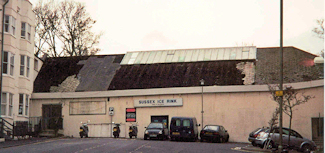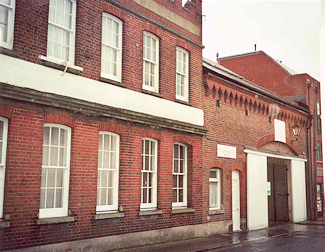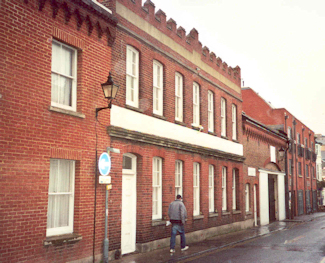Brighton
Drill Hall, Queens Square
Drill Hall, Church street
117 Gloucester road
Coombe road
9 Hampton place
23 Gloucester place
18 Montpelier place
Drill Hall, Church street
117 Gloucester road
Coombe road
9 Hampton place
23 Gloucester place
18 Montpelier place
Church street:
Head quarters, 1st & 2nd Sussex Batteries, Ammunition Column, 1st Home Counties Brigade Royal
Field Artillery, Drill hall, Church street
117 Gloucester Road:
'Sussex Royal Garrison Artillery; Nos. 1 & 2 Cos., Gloucester road.'
Coombe road:
'Coombe road, Lewes road; (half of) 1st Home Counties Field Company Royal Engineers.'
Also 'Home Counties Divisional Telegraph Co.'
9 Hampton Place
Head quarters, Sussex Yeomanry; 9 Hampton place
ds 'B' Squadron Sussex Yeomanry
23 Gloucester Place:
Headquarters 1,2,3,4 Sections Home Counties Signal Company Royal Engineers
18 Montpelier place:
Headquarters, A-H 6 Royal Sussex
117 Gloucester Road:
'Head quarters Co. Home Counties Divisional Transport & Supply Column Army Service Corps'
'2nd Eastern General Hospital; head quarters.'
(All references Kelly, 1911)
East Sussex Record Office hold plans marked 'Territorial Drill Hall, Queens Square, by Sanders - ref. DB/D/46/825 - date: 21 May 1914'.
The Mash Tun public house on Church Street was formerly The Volunteer, named to commemorate the units which used the infantry barracks.
The Volunteers moved to the drill halls in Church street and Gloucester road.
The drill hall on Church street is extant and is opposite a plot of waste ground at the cross roads where Portland street and Spring Gardens meet Church street. It is a substantial three storey building with a large hall to the rear.
According to Peter Crowhurst, published on the North Laine Community Association website, this is:
'...the former drill hall of the Volunteer Rifles of the Royal Sussex Regiment. They had been formed in 1859 when there was fear of war with the French. At first the volunteers met in the Church Street barracks and then in the Town Hall before moving here in 1890. Colonel Tamplin secured the move. The volunteers won many prizes in shooting competitions and were one of the first units to use cyclists as messengers.'
East Sussex Record Office hold plans dated 2nd January, 1890, which refer to 'Church Street - drill hall / 1st V.B.R.S.R. [1st Volunteer Battalion Royal Sussex Regiment] / Scott & Cawthorpe'.
We have been informed that the building is used as a sorting office by the Royal Mail, but we would be grateful for up-to-date information.
'... the shell of the former drill hall for the Sussex Artillery Volunteers, formed in 1859 at the time of the French invasion threat. There had been the Eagle Iron Foundry on the site but this was refurbished for the Volunteers, with an officers' mess, rest rooms and similar facilities for the sergeants and NCOs. The gunners were also to have a recreation room although their smoking was restricted. Initially the complex included a canteen and a house for the sergeant major but when Colonel Hannington retired these were removed. At this time there were 560 volunteers and by the 1880s 4 16-pounders. The artillery volunteers were responsible for the organisation of the yearly (Easter) training exercises in Sheepcote valley.'
He states that the building was used as a warehouse before its conversion into apartments.
Extracts from the North Laine Community Association website are quoted with permission of the author, Peter Crowhurst. We are very grateful. Thanks too to Helen Cornish of the North Laine Community Association. Mr Crowhurst recommends 'The Brighton Garrisons, 1793 – 1900', by R C Grant, and 'The Encyclopaedia of Brighton' by Timothy Carder, for more detailed information.
Head quarters, 1st & 2nd Sussex Batteries, Ammunition Column, 1st Home Counties Brigade Royal
Field Artillery, Drill hall, Church street
117 Gloucester Road:
'Sussex Royal Garrison Artillery; Nos. 1 & 2 Cos., Gloucester road.'
Coombe road:
'Coombe road, Lewes road; (half of) 1st Home Counties Field Company Royal Engineers.'
Also 'Home Counties Divisional Telegraph Co.'
9 Hampton Place
Head quarters, Sussex Yeomanry; 9 Hampton place
ds 'B' Squadron Sussex Yeomanry
23 Gloucester Place:
Headquarters 1,2,3,4 Sections Home Counties Signal Company Royal Engineers
18 Montpelier place:
Headquarters, A-H 6 Royal Sussex
117 Gloucester Road:
'Head quarters Co. Home Counties Divisional Transport & Supply Column Army Service Corps'
'2nd Eastern General Hospital; head quarters.'
(All references Kelly, 1911)
Drill Hall, Queens Square:
An article in the Argus, 17th December, 2002, reported that the ice-rink in Queens Square was to be
sold. It had been set up more than thirty years before, the ice rink occupied what the Argus
described as 'an old Territorial Army drill hall'. We have not yet been able to confirm either the age
of the premises or whether they are still extantEast Sussex Record Office hold plans marked 'Territorial Drill Hall, Queens Square, by Sanders - ref. DB/D/46/825 - date: 21 May 1914'.
Barracks – before the drill halls
The infantry barracks in Brighton occupied the plot of land edged by Church street, Marlborough
Place and North road. They were used by the 1st Sussex Artillery Volunteers and the 1st Sussex
Rifles, and, according to the mybrightonandhove.org.uk. website, finally closed in 1870. The building
was demolished and the site was used for a slipper bath and a county court building. It is now
marked by the name Barrack Yard.The Mash Tun public house on Church Street was formerly The Volunteer, named to commemorate the units which used the infantry barracks.
The Volunteers moved to the drill halls in Church street and Gloucester road.
Church street:
Pevnser's 'The Buildings of England' describes 'the former Drill Hall of the Royal Sussex Regiment,
1889-90 by E. Scott, [as] a queer building, long, with segment-headed windows, and a portal, as if it
stood in Salzburg and dated from the C17.'The drill hall on Church street is extant and is opposite a plot of waste ground at the cross roads where Portland street and Spring Gardens meet Church street. It is a substantial three storey building with a large hall to the rear.
According to Peter Crowhurst, published on the North Laine Community Association website, this is:
'...the former drill hall of the Volunteer Rifles of the Royal Sussex Regiment. They had been formed in 1859 when there was fear of war with the French. At first the volunteers met in the Church Street barracks and then in the Town Hall before moving here in 1890. Colonel Tamplin secured the move. The volunteers won many prizes in shooting competitions and were one of the first units to use cyclists as messengers.'
East Sussex Record Office hold plans dated 2nd January, 1890, which refer to 'Church Street - drill hall / 1st V.B.R.S.R. [1st Volunteer Battalion Royal Sussex Regiment] / Scott & Cawthorpe'.
We have been informed that the building is used as a sorting office by the Royal Mail, but we would be grateful for up-to-date information.
Gloucester road:
The drill hall on Gloucester road is extant. It is the crenellated red-brick building on the north side of
Gloucester Road, opposite the little group of properties between Robert Street and Vine Street. Aerial
photographs show a large hall to its right. It has been converted into residential apartments.
According to Peter Crowhurst, as above, this is:'... the shell of the former drill hall for the Sussex Artillery Volunteers, formed in 1859 at the time of the French invasion threat. There had been the Eagle Iron Foundry on the site but this was refurbished for the Volunteers, with an officers' mess, rest rooms and similar facilities for the sergeants and NCOs. The gunners were also to have a recreation room although their smoking was restricted. Initially the complex included a canteen and a house for the sergeant major but when Colonel Hannington retired these were removed. At this time there were 560 volunteers and by the 1880s 4 16-pounders. The artillery volunteers were responsible for the organisation of the yearly (Easter) training exercises in Sheepcote valley.'
He states that the building was used as a warehouse before its conversion into apartments.
Extracts from the North Laine Community Association website are quoted with permission of the author, Peter Crowhurst. We are very grateful. Thanks too to Helen Cornish of the North Laine Community Association. Mr Crowhurst recommends 'The Brighton Garrisons, 1793 – 1900', by R C Grant, and 'The Encyclopaedia of Brighton' by Timothy Carder, for more detailed information.
Coombe road:
Shown on the 1912 OS map between Coombe road and Milner road, at the junction with Buller road.9 Hampton Place:
We presumed this to be offices only, as yeomanry rarely had their own drill hall. There is nothing
marked on the old OS maps.
Queens Square Drill Hall

Gloucester Road Drill Hall

Gloucester Road Drill Hall
© All material is copyright - refer to the
Terms of Use
the first attempt at content
Introduction
About
Anatomy
Drill
 Database
Database
 Memorabilia
Memorabilia
Resources Glossary
Saving Halls Participate Contact What's New? Terms of Use
Drill
 Database
Database Memorabilia
MemorabiliaResources Glossary
Saving Halls Participate Contact What's New? Terms of Use
The Drill Hall Project - Charting a neglected legacy